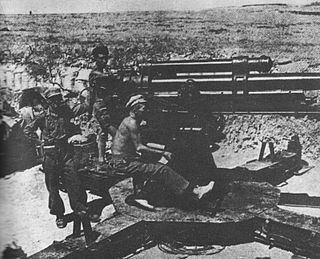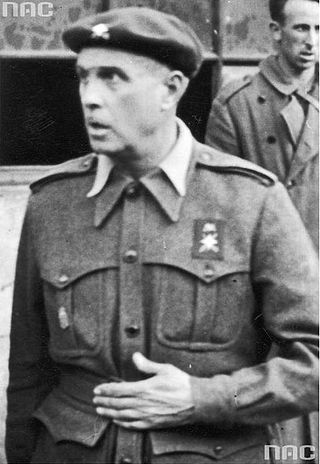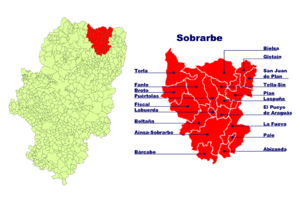
The Battle of the Ebro was the longest and largest battle of the Spanish Civil War and the greatest, in terms of manpower, logistics and material ever fought on Spanish soil. It took place between July and November 1938, with fighting mainly concentrated in two areas on the lower course of the Ebro River, the Terra Alta comarca of Catalonia, and the Auts area close to Fayón (Faió) in the lower Matarranya, Eastern Lower Aragon. These sparsely populated areas saw the largest array of armies in the war. The battle was disastrous for the Second Spanish Republic, with tens of thousands left dead or wounded and little effect on the advance of the Nationalists.

The Battle of Teruel was fought in and around the city of Teruel during the Spanish Civil War between December 1937 and February 1938, during the worst Spanish winter in 20 years. The battle was one of the bloodiest actions of the war, with the city changing hands several times by first falling to the Republicans and eventually being retaken by the Nationalists. In the course of the fighting, Teruel was subjected to heavy artillery and aerial bombardment. In the two-month battle, both factions together took 110,000 casualties.

The Battle of Santander was fought in the War in the North campaign of the Spanish Civil War during the summer of 1937. Santander's fall on 26 August assured the Nationalist conquest of the province of Santander, now Cantabria. The battle devastated the Republic's "Army of the North"; 60,000 soldiers were captured by the Nationalists.

The War in the North was a theatre of the Spanish Civil War that occurred in northern Spain from 31 March to 21 October 1937.

The Aragon Offensive was an important military campaign during the Spanish Civil War, which began after the Battle of Teruel. The offensive, which ran from March 7, 1938, to April 19, 1938, smashed the Republican forces, overran Aragon, and conquered parts of Catalonia and the Levante.

The Catalonia Offensive was part of the Spanish Civil War. The Nationalist Army started the offensive on 23 December 1938 and rapidly conquered Republican-held Catalonia with Barcelona. Barcelona was captured on 26 January 1939. The Republican government headed for the French border. Thousands of people fleeing the Nationalists also crossed the frontier in the following month, to be placed in internment camps. Franco closed the border with France by 10 February 1939.

José Solchaga Zala was a Spanish general who fought for the Nationalists in the Spanish Civil War.

The XYZ Line, also known as the Matallana Line, was a system of fortifications built in 1938 during the Spanish Civil War to defend Valencia, the capital of the Second Spanish Republic. The XYZ Line was a simple system of trenches and bunkers, built to withstand heavy artillery or 450-kilogram (992 lb) aerial bombs, and took advantage of some of the most difficult terrain in Spain in the Iberian System ranges to the north and northeast of Valencia. The XYZ Line was successful at halting the Nationalist advance on Valencia, being one of the last Republican victories of the war, and allowed the Republicans to start the Battle of the Ebro.

The Peña Montañesa is a conspicuous rocky mountainous outcrop of the Pre-Pyrenees. It is located east of the valley of the Cinca, in the Sobrarbe comarca, Aragon, Spain. The ridge's highest summit is 2295 m high. The village of Laspuña is located at the feet of the mountain.

The Asturias Offensive was an offensive in Asturias during the Spanish Civil War from 1 September to 21 October 1937.

The Segovia Offensive was a Republican diversionary offensive which took place between 31 May and 6 June 1937, during the Spanish Civil War. The main goal of the offensive was to occupy Segovia and divert Nationalist forces from their advance on Bilbao. After a brief initial advance the offensive failed due to Nationalist air superiority.

The Huesca Offensive was an operation carried out during the Spanish Civil War by the Republican Army in June 1937 in order to take the Aragonese city of Huesca, which since the start of the war in July 1936 had been under the control of the Nationalist forces.
The Battle of Caspe took place during the Aragon Offensive of the Spanish Civil War in 16–17 March 1938.
The Battle of Gandesa took place in April 1938 during the Spanish Civil War.

The battle of the Mérida pocket, also known as the closing of the Mérida pocket, was a military engagement which took place during the Spanish Civil War in July 1938 in La Serena zone of Badajoz Province, Extremadura.
The Zaragoza Offensive took place during the Spanish Civil War in 1937. This battle involved the Spanish Republican Army. The main goal of the offensive was to occupy the city of Zaragoza. The main action of the offensive was the battle of Belchite.

The Levante Offensive, launched near the end of March 1938, was an attempt by Nationalist forces under Francisco Franco to capture the Republican held city of Valencia during the Spanish Civil War. The Nationalists occupied the province of Castellón, but the offensive failed due to bad weather and the dogged resistance of the Republican troops at the XYZ defensive line.

The Eastern Region Army Group, Spanish: Grupo de Ejércitos de la Región Oriental (GERO), was a military formation of the Spanish Republican Army during the last phase of the Spanish Civil War. It was established in June 1938 as a response to the splitting in two of the territory under the sovereignty of the Spanish Republic after the Central Region Army Group (GERC), under the command of General Miaja, had been set up in the central-southern region of Spain.
The 24th Division was one of the divisions of the Spanish Republican Army that were organized during the Spanish Civil War on the basis of mixed brigades. Throughout the war, the unit was deployed on the Andalusian, Madrid, Aragon and Segre fronts, taking part in some of the main battles.
The X Army Corps was a military formation belonging to the Spanish Republican Army that fought during the Spanish Civil War. During the war it was deployed on the fronts of Aragon, Segre and Catalonia.















